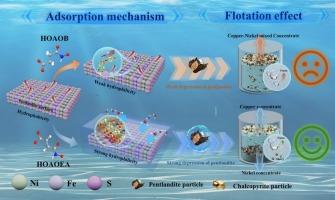Enhanced effect of depressant for the flotation separation of chalcopyrite from pentlandite via chemical and spatial selectivity
IF 5
2区 工程技术
Q1 ENGINEERING, CHEMICAL
引用次数: 0
Abstract
Focusing on the difficulty of separating chalcopyrite from pentlandite, this study pioneers a chemical-spatial dual-selectivity strategy to design depressants for pentlandite. Based on this strategy, two small-molecule organic depressants, 4-hydroxyamino-4-oxobut-2-enoic acid (HOAOEA) and 4-hydroxyamino-4-oxobutanoic acid (HOAOB), were synthesized. The advantages of the chemical-spatial dual-selectivity strategy in the design of effective small-molecule depressants were explored through a comparative study of the flotation and adsorption behavior of HOAOEA and HOAOB. DFT calculations revealed that HOAOEA with chemical-spatial selectivity allowed the simultaneous coordination of Ni/Fe sites on the surface of pentlandite through electron delocalization effect and planar adsorption structures and the formation of multilayered adsorption through intermolecular π-π interactions, resulting in a dense hydrophilic film on the mineral surface. The flotation results demonstrated that HOAOEA was an excellent depressant by selectively depressing the flotation of pentlandite with better performance than HOAOB. This study not only pioneers the application of a chemical-spatial dual-selectivity design strategy for developing small-molecule depressants in mineral flotation, but also facilitates the efficient exploitation of copper-nickel resources.

抑制剂通过化学选择性和空间选择性增强了黄铜矿与镍黄铁矿浮选分离的效果
针对黄铜矿与镍黄铁矿分离的困难,本研究提出了一种化学-空间双选择性策略来设计镍黄铁矿抑制剂。在此基础上,合成了两种小分子有机抑制剂——4-羟氨基-4-氧丁-2-烯酸(HOAOEA)和4-羟氨基-4-氧丁酸(HOAOB)。通过对HOAOEA和HOAOB的浮选和吸附行为的比较研究,探讨了化学-空间双选择性策略在设计有效小分子抑制剂中的优势。DFT计算表明,HOAOEA具有化学空间选择性,可通过电子离域效应和平面吸附结构使镍镍矿表面的Ni/Fe位点同时配位,并通过分子间π-π相互作用形成多层吸附,在矿物表面形成致密的亲水膜。浮选结果表明,HOAOEA是一种优良的抑制剂,可选择性抑制镍黄铁矿的浮选,其性能优于HOAOB。该研究不仅开拓了化学-空间双选择性设计策略在矿物浮选中开发小分子抑制剂的应用,而且为铜镍资源的高效开发提供了便利。
本文章由计算机程序翻译,如有差异,请以英文原文为准。
求助全文
约1分钟内获得全文
求助全文
来源期刊

Minerals Engineering
工程技术-工程:化工
CiteScore
8.70
自引率
18.80%
发文量
519
审稿时长
81 days
期刊介绍:
The purpose of the journal is to provide for the rapid publication of topical papers featuring the latest developments in the allied fields of mineral processing and extractive metallurgy. Its wide ranging coverage of research and practical (operating) topics includes physical separation methods, such as comminution, flotation concentration and dewatering, chemical methods such as bio-, hydro-, and electro-metallurgy, analytical techniques, process control, simulation and instrumentation, and mineralogical aspects of processing. Environmental issues, particularly those pertaining to sustainable development, will also be strongly covered.
 求助内容:
求助内容: 应助结果提醒方式:
应助结果提醒方式:


